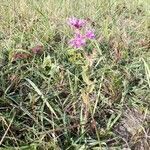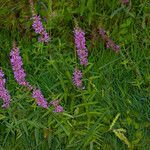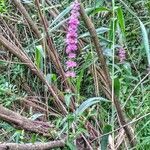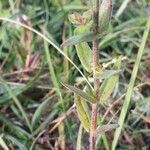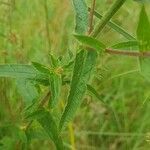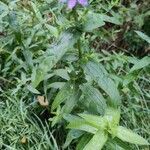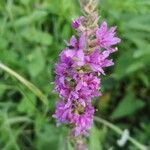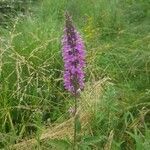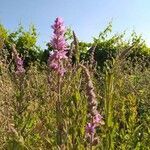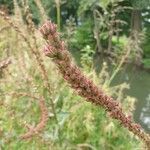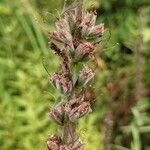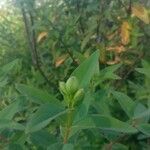Perennial herbs or subshrubs, 0.3-1.5 m tall, scabrous or sparsely to densely gray pubescent [or tomentose], sometimes somewhat glabrescent. Stem erect, 4-angled. Leaves opposite or 3-whorled, sometimes alternate toward stem apex, ovate-lanceolate to broadly lanceolate, 2.5-10 × 0.5-1.5 cm, base rounded, truncate, or semiclasping, apex acute to subobtuse. Inflorescences terminal, spicate, 15-35 cm; bracts broadly lanceolate or deltoid-ovate. Flowers in 1-to multi-flowered whorled axillary cymes, shortly pedicellate. Floral tube 5-8 × 1.5-2 mm, 12-ribbed; sepals deltate, 0.5-1 mm; epicalyx segments erect, linear, 1.5-2 mm, much longer than sepals. Petals reddish purple to rose-purple, lanceolate-oblanceolate, 7-10 × 1.5-3 mm. Fl. Jul-Sep, fr. Oct. 2n = 30, 50, 58, 60.
Herb, erect, annual above ground, perennial below, glabrous or pubescent. Stems angular, to 1.5 m high. Leaves mostly opposite, sometimes whorled, rarely some alternate, sessile, narrowly ovate to oblong-lanceolate, 1.5–7 cm long, acute, the base stem-clasping or rounded to auriculate. Flowers subsessile in clusters, usually 3–5 in axils of upper leaves forming elongate spike-like panicles. Hypanthium cylindrical to elongate and narrowly campanulate, c. 5 mm deep, 1.5–2 mm wide; appendages 5 or 6, subulate, 2–3 mm long. Sepals 5 or 6, deltate, c. 1 mm long. Petals 5 or 6, ovate, 8–10 mm long, blue, pink or purple. Stamens usually 12, usually dimorphic with 6 long-exserted. Capsule ovoid, 3–4 mm long, enclosed in hypanthium.
Stout, erect perennial herb 5–15 dm, glabrous or more often pubescent or, especially upwards, even subtomentose; lvs opposite or ternate, sessile, lanceolate to nearly linear, 3–10 cm, the larger ones cordulate at base; spikes 1–4 dm, interspersed with foliaceous, lanceolate to ovate bracts; fls trimorphic as to the style and stamens; appendages of the hypanthium linear, fully twice as long as the sep; pet red-purple, 7–12 mm; stamens mostly 12, alternately longer and shorter; disk wanting; 2n=30, 50, 60. Native of Eurasia; in wet places from Nf. and Que. to N.D., s. to Va., Mo., and Kans., and occasionally w. to the Pacific. July–Sept.
A herb. It grows to 60-150 cm tall and 45-60 cm wide. It keeps growing from year to year. Young growth is usually hairy. It has strong upright stems. These arise from a clump of downy leaves. The leaves are 2-7 cm long by 1 cm wide. The flowering stalk is spike like and very long. The flowers are small and starry. They are about 1.8 cm across. They can be pink or purplish red. The fruit is a small capsule enclosed in a tube of the flower. One mature plant can produce one million seeds.
